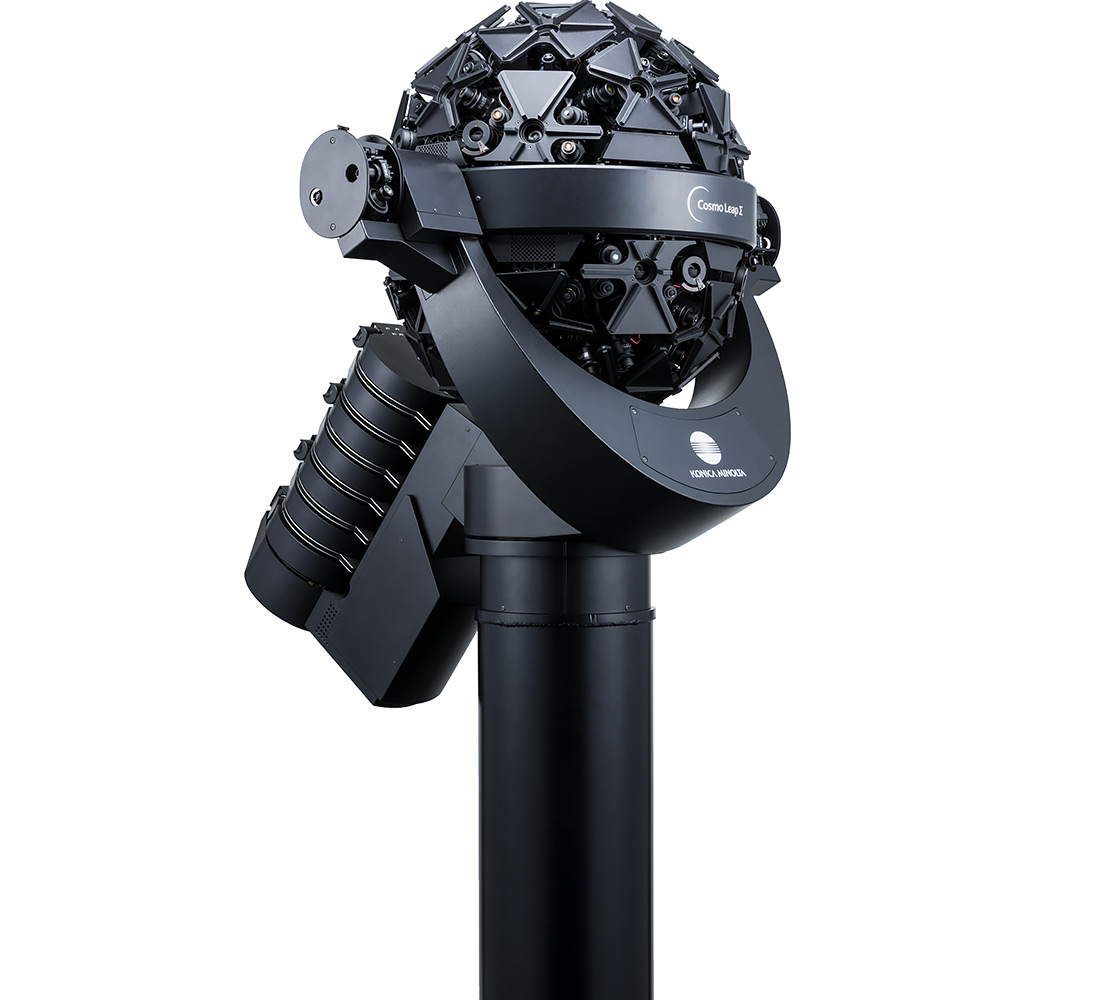
Cosmo Leap Σ
The Cosmo Leap Σ can project the starry sky equivalent to those of the Infinium Σ (Konica Minolta’s flagship optical planetarium that was developed to project beautiful fixed stars shining in the dark night sky) in small and medium-sized domes with an energy-efficient compact design.
Japan is the second most planetarium installed country after the United States of America. It has over 300 facilities and 75% of them are installed by governing bodies, mostly in medium-sized domes ranging approximately 10m in diameter.
In these small and medium-sized domes, Cosmo Leap Σ achieves sharp stellar images with various constellation images and realistic projections of variable stars (i.e., features suitable for giving a detailed narrative of the starry sky) and impresses the audience by projecting a beautiful night sky embellished with glittering stars.

Meaning of Cosmo Leap
“Cosmo Leap” is named it after a quote by Neil Armstrong, commander of Apollo 11.
“That's one small step for a man, one giant leap for mankind.”
2018 Good Design Gold Award winner
「The Cosmo Leap Σ was selected as one of the Good Design Best 100 products out of 4,789 products and services that were subject to screening. It then won a Good Design Gold Award, which is presented to the outstanding designs selected from the 100 best products. The Cosmo Leap Σ is designed to blend harmoniously with cosmic space, representing the company’s wish to arouse children’s creativity and spirit of inquiry.
Features of the Design
With its compact structure incorporating optical technology, the product is designed to blend harmoniously with cosmic space.
Comments from Screening Committee of JDP
While most products cover their structures with some materials, the planetarium is exposed. Its mechanical appearance, made of optical and precision components, appeals to people, especially children. Since the moving parts of the star ball and planet projector follow the movement of the night sky (movement of the Earth), the orderly structure of this precision machine makes children aware that cosmic space is also regularly structured. This aspect of the product was also highly regarded by the jury.
See here for the Good Design Award website

Main Features
| Suitable Dome Diameter | 8~18m (Horizontal) | |
|---|---|---|
| Projector Size | External dimensions | 980mm(W)× 960mm(D)× 2530mm(H)(when dome horizon is at 2.2m) |
| Footprint | 1m(W)×1m(D) *Not including fence | |
| Time Settings | Able to display the starfield from a given time and date within the Solar System (±4000 years) | |
| Able to switch between Universal Time, Local Standard Time, and Local Mean Time. | ||
| View Point Settings | Able to display the starfield from a given target or location within the Solar System. (Map input available) | |
Star Ball and Planet Farm
| Projection Method | Lens Projections, Ultra bright LEDs (lifetime 30,000 hours), 32 divisions |
|---|---|
| Shutters | Gravitational |
| Fixed Stars | Approx. 9,000 (Over 6.5 mag) |
| Brightness of the stars | Brightness differences for each star reproduced |
| Color | 97 different stars colored, down to magnitude 2.5 |
| Bright Stars / Variable Stars | 27 with individual color characteristics and scintillation, individual scintillation patters available 4 Variable Stars: Algol, Betelgeuse, Dschubba (δSco)、Mira (individual light curves available) |
| Deep Sky Objects | 48 objects processed on star plates |
| Constellations / Additional Markers | 80 objects (some projected simultaneously) |
| Milky Way | 250,000 Stars processed on Star plates |
| (OP): Separate projection, lens projection, individual dimming available * Several constellation images and additional markers will be reduced from the standard specification |
Additional Projections
| Cardinal Points | Indicating North, South, East and West using ultra bright LEDs |
|---|---|
| Sunrise and Sunset*Op | Simulation for sunrise and sunset using ultra bright LEDs |
| Twilight, Dawn and Dusk*Op | Simulation for twilight, dawn and dusk using ultra bright LEDs |
| Sun | Simulation of movement seen from Earth, 1 degree projection, Ultra bright LEDs |
| Moon | Simulation of movement and phasing seen from Earth (individual phasing), 1 degree projection, Phasing features, Ultra bright LEDs |
| Planets | Simulation of movement seen from Earth, Point projections, Ultra bright LEDs |
| Mercury, Venus, Mars, Jupiter, Saturn | |
| Ecliptic and Equatorial coordinates*Op | Ultra bright LEDs |
| Meridian*Op | Ultra bright LEDs |
*Op = Optional / *Specifications are subject to change without notice
Controls
| Performance | Diurnal motion on planets and satellites, etc. |
|---|---|
| Automated Control | 10,000 standard program data storable, programs can be paused and played from the middle, manual interruption available |
| Automatic recovery, able to simultaneously control both manual and automatic controls | |
| Manual Control | Interlinked dimming (stars and planets), immediate projection of that day’s sky, map and star map input available |
| Macro Functions | Available by control from the console and operation screen, ordering from auto programs are also available |
| Hyper Programming | Original GUI available by HyperText Markup Language |
| Function buttons, macro buttons, texts and remote connecting available | |
| Auto-performance Programming | Integrated script format, command input method, real time commanding, timeline editing available |
| Others | One-button reset, remote diagnosing, integration with digital projectors |

